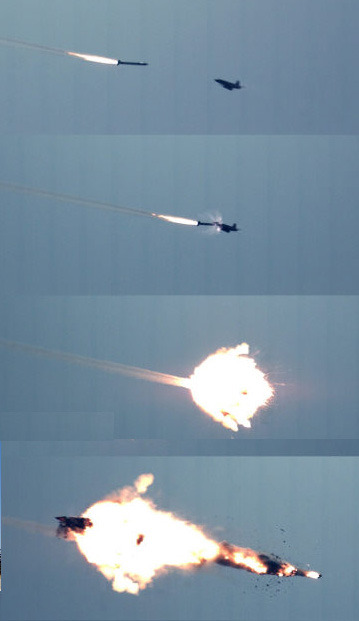- Yes
- No
(KM-SAM) Block-I

TL;DR: South Korean multi-vehicle medium-range SAM system
History
In the late stages of the Cold War, medium-range SAM systems of the Republic of Korea Air Force were limited to the American MIM-14 Nike Hercules and MIM-23B I-Hawk. These were rapidly aging, and as such, South Korea intiated the SAM-X program in 1991 to replace the MIM-14s. In 1999, a separate program began to develop a domestic SAM system to replace the MIM-23Bs, designated Cheolmae-II (鐵鷹-2, 鐵鷹 meaning Iron Hawk, with the MIM-23B having the designation 鐵鷹 in South Korean service) was launched.
Both programs were fraught with delays. In 1999, S-400 technology was transferred from Russia to South Korea for the Cheolmae-II. Meanwhile, for the SAM-X, the military could not initially agree on whether to purchase American Patriots or Russian S-300s. They eventually agreed on the Patriot (PAC-3) and intended to sign an agreement with Raytheon in 2001, but this was postponed. By 2005, South Korea had begun to withdraw the MIM-14s from service without any progress on the acquisition of the Patriots. In 2007, South Korea turned to Germany for used PAC-2 missiles. In 2008, Raytheon received a contract from the US to provide South Korea with support and training equipment for the Patriot, and in the same year, Germany agreed to the sale of the PAC-2. The first shipment arrived in November that year.
Meanwhile, with assistance from Russia, development of the Cheolmae-II was progressing. In 2010, the official name of the missile system — Cheongung (천궁) — was announced. It is also known as the KM-SAM (Korean Medium-range Surface-to-Air Missile). In mid-2015, it was announced that the Cheongung would soon enter mass production. It was first deployed in 2016. In 2020, delivery was complete, and in 2021, the last MIM-23 Hawk was retired from service.
Development of a further variant — Cheongung Block-II — was being carried out while the Cheongung (Block-I) was in production. This variant features increased range and altitude, and features a different warhead, requiring a direct-hit. The first of these missiles was tested in 2015, and the first Block-II systems were delivered in late 2020.
Development of the Block-III is ongoing, beginning last year (2024). It will feature an upgraded AESA radar on both the radar vehicle and the missile seeker, increased missile range, and improved missile software.

- KM-SAM Block-II battery in middle. From left to right: Multi-function radar (MFR) vehicle, launcher vehicle, and command-and-control vehicle
Characteristics:
Missiles
The Cheongung Block-I is 4.61m long, 27.5cm wide, weighs 400kg, and has a maximum speed of Mach 4.5 (~1500m/s). The missiles are vertical cold launched, with the missile first being launched upward before the rocket itself is ignited. Side thrusters direct the missile in the right direction before the rocket is ignited.
- KM-SAM Block-I launch stages
The missile has an effective range of 40km, with a 20km (or 15km, sources vary) flight ceiling, and a maximum maneuverability of 50g. It has a directional fragmentation blast warhead, that aims fragments in the direction of the aircraft. The missile is initially guided by information from the radar vehicle, but when closer to the target, switches to ARH using a Ku-Band radar seeker.
- Block-I vs Block-II missile diagram. Block-II missiles have a hit-to-kill warhead.
Radar
The KM-SAM employs a PESA X-band multi-function radar, designated MPQ-540K. When searching, it rotates 360° 40 times a minute, with an elevation of -3° to 80°. It has a maximum detection range of around 100km (some sources indicate up to 120 or 150km for aircraft), and can track up to 40 targets simultaneously. Once locked on a target, the radar has a 45° view left and right, and -3–80° up and down.
- KM-SAM radar vehicle
Vehicles
The laucher, command-and-control, and radar vehicles are all based on the K916 and K917 8x8 cargo truck family, developed by Kia specifically for the Cheongung, and based on the K912. Specifically, the launcher and radar vehicles use the K916 chassis, and the command centre uses the K917. The power generator vehicles use the K917 chassis, and the reloading vehicles use the K918. These two are auxillary, however, and not required for the battery to function.
- KM-SAM launcher vehicle
The launcher carries 8 missiles, with up to 6 vehicles in a single battery. The launcher is 11m x 2.6m x 4m in size (height with launchers down). The radar vehicle is the same size (excluding the actual radar), and weighs 18t. The control centre is 11m x 3m x 4m. The trucks all have a 450hp D6CA engine, providing a top speed of 90km/h.
- KM-SAM command vehicle
Conclusion
With the update ‘Leviathans’ implementing multi-vehicle SAM systems, the door is open for many nations to receive their own. The KM-SAM Block-I would be the logical top SPAA for a future United Korean Ground Forces tech tree. It would have missile performance on par with, if not slightly better than, the new SAM systems, and as such should go at a BR of 12.0 or higher.
Specifications
Armament
- 8x Cheongung Block-I (per launcher vehicle)
- ARH guidance
- Effective range: 40km
- Flight ceiling: 15–20km
- Manoeuvrability: 50g
- Maximum speed: ~1500m/s
- Warhead
- Directional fragmentation blast
- Weight: 400kg
- Dimensions: 4.61m x 0.275m
Mobility
- Speed
- 90km/h, 12 gears
- Weight
- 18t (radar vehicle)
- Engine power
- 450hp D6CA, 25hp/t (radar vehicle)
Images
Sources















